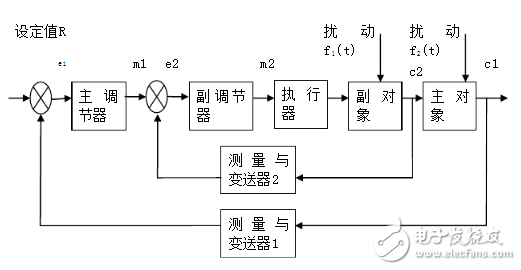In China, with the development of society, automatic control has been implemented very early. In China, the liquid level control system has also been widely used, especially the water level control of the water tank is also utilized in the Yellow River water control. The water level control system is used to detect the water level of the Yellow River, so as to avoid the water level of the Yellow River being too high and not knowing. Bringing life and danger to our people. This article introduces the design of a double tank water level control system.
DesignThe cascade control system established by the design consists of two main and two control loops, each of which has its own regulator and control object. The regulator in the main circuit is called the main regulator and controls the main object. The regulator in the secondary circuit is called the secondary regulator and controls the secondary object. The main regulator has its own independent set value R, its output m1 is the given value of the sub-regulator, and the output m2 of the sub-regulator controls the actuator to change the main parameter c2. It is controlled by the liquid level for the double-capacity tank. The process design cascade control system will try to make the output response of the system in steady state, the controlled amount of the system is equal to the given value, realize the no-difference adjustment, and make the system have good dynamic performance and block response speed. When a disturbance f1(t) acts on the secondary object, the secondary regulator can act before the disturbance affects the main control parameter, and timely overcome various secondary disturbances entering the secondary circuit. When the disturbance f2(t) acts on the primary object, Due to the presence of the secondary circuit, the response of the system should be accelerated, and the control of the primary loop is strengthened.

Cascade control system block diagram
(1) Selection of controlled parametersThe parameters in the controlled process that directly reflect the yield and quality of the product in the production process and are easy to measure should be selected. In the dual-tank control system, the liquid level of the lower tank is selected as the system controlled parameter, because the liquid level of the lower tank is the key to the overall control, and the liquid level is required to be maintained above and below a given value. If the adjustment is not proper, it will cause the failure of the entire system control design, and now there are mature technologies and equipment for the measurement of liquid level, including direct reading level gauge, buoyancy level gauge, static pressure level gauge, Electromagnetic level gauge, ultrasonic level gauge, etc.
(2) Selection of control parametersFrom the point of view of the dual-tank tank system, there are two factors affecting the liquid level, one is the flow into the system through the upper tank, and the other is the flow out of the system through the lower tank. Adjusting both flow rates can change the level of the liquid level. However, when the electric control valve is suddenly turned off and off, the latter control method will cause long flowing water, causing excessive water overflow in the water tank, resulting in waste or accident. Therefore, it is more reasonable to choose the flow into the system as the control parameter.
(3) Main and auxiliary circuit designIn order to achieve liquid level cascade control, a double closed loop structure is used. The secondary circuit should have strong suppression ability and certain adaptive ability for the secondary disturbance and the nonlinear parameters and large load changes contained therein. The ratio of the primary and secondary loop time constants should be between 3 and 10, so that the secondary loop is both responsive and significantly improves process characteristics. The lag of the capacity of the lower tank is larger than that of the upper tank, and controlling the liquid level of the lower tank is the core problem of the system design. Therefore, the main object is the lower tank and the secondary object is the upper tank.
(4) Controller selectionAccording to the process characteristics and mathematical model of the double tank water level system, the control law of the controller is selected. In order to realize the liquid level cascade control, the double closed loop structure is adopted, the main regulator selects the proportional integral differential control law (PID), adjusts the liquid level of the lower tank, and the proportional control rate (P) of the secondary regulator selects the liquid level of the upper tank. The adjustment is made and the main regulator is assisted to control the system, and the entire loop constitutes a double loop negative feedback system.
USB 3.0 is the future and the new generation in transmission tech, with the following advantages: Super speed – It`s 10 times faster than its predecessor and backward compatible with all USB 2.0 interfaces. It uses a 9-pin connector with 4 pins compatible with USB 2.0 and another 5 pins for bi-directional data transfer.
External Differences
The USB 3.0 connector is blue.
The top 5 pins provide the two-way data transfer.
The bottom 4 pins provide backward compatibility with USB 2.0.
Note: All USB 3.0 Interfaces are blue
Usb 3.0 Cable,Usb3 Cable,3.0 Usb Port,Micro Usb 3.0 Cable
UCOAX , https://www.jsucoax.com